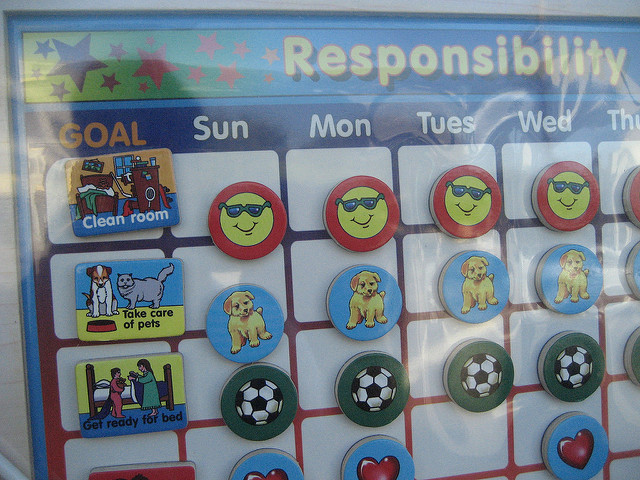One of the hardest decisions of my adult life was resigning from my full-time reporting job to become a stay-at-home mom.
After all, I was finally making top rate, had just acquired a third week of holidays and had a set, dependable schedule. I enjoyed my job, the people I worked with and the money.
Never in a million years did I think motherhood would affect my career goals, especially after completing 4+ years of post secondary education.
But after the birth of my second daughter, Zoe, I had a change of heart, which ultimately led to a DRASTIC change of lifestyle.
Once the maternity pay came to an end, our savings quickly dwindled.
Having to ask Jason whether I could buy a tube of mascara was humbling… especially when his answer was that we’d have to wait until payday.
Fortunately, I’ve been able to make a go at a full-time freelance career — heck, I’ll even go as far as to toot my own horn and say I’ve been doing pretty well for myself. *Toot.* *Toot.*
As a freelancer, it can be feast or famine, so I’ve also had to learn how to be frugal. I’d estimate that around a good 75% of my wardrobe is thrifted. We also cut back, big-time, on dining out, ordering in, or purchasing each other any big gifts during the holidays.
Despite the money coming in and our newfound knack for frugality, there’s always that worry that we could be earning more, saving more and investing more. But where does one even begin?
Engaging financial guru Sybil Verch offers practical real world advice on money matters on her new hit show “The Wealthy Life,” which airs on CHEK every Sunday at 6:30 p.m.. In-studio guests present their fiscal challenges, and Sybil and guest experts offer real solutions to help them take charge of their own personal finances.
Sybil offers ValleyMom.ca her practical real world advice on money matters, which I’m sure many of you fellow Valley Moms & Dads can relate to, in a Q & A -style interview below:
1. I’m a self-employed, freelance writer, so my income is always fluctuating. This can make financial planning for our family difficult. What advice do you have for families with fluctuating incomes and how to properly set up your children and family for financial success?
Parents with fluctuating incomes can make it challenging to budget and plan for the future, but I do have some tips to help.
Step one is to analyze your cash flow to get a firm handle on what you truly need (vs want) to cover necessary monthly expenses. Step two is to start setting money aside whenever possible (in those months where income exceeds expenses) to build an emergency fund that can be used during periods of low or no income. I suggest an emergency fund equal to at least 3 months’ worth of expenses, but preferably 6 months.
Once accomplished, you can move to Step three which is to start a savings / investment program to fund future needs. Establish a set of goals first to inspire you to save (ie. family vacation, retirement funding, kids’ education). I believe it’s important to have some fun short term goals (like a trip) mixed in with important long term goals (like retirement funding) so you get the benefit of shorter term enjoyment / rewards while also saving for longer term goals. Once you have an emergency fund established and a good handle on what you need to save each month, establish an automatic savings plan whereby a set dollar amount is automatically withdrawn from your bank account and sent to your investment account. Treat your savings like a mandatory monthly expense (forced savings) and things should fall into place nicely. In the month’s where you might fall a bit short, use your emergency fund to make up the difference, then rebuild the emergency fund once again.
Engage the family in the goal setting process so everyone is onside to watch expenses and contribute to savings (kids would have their own smaller goals and savings to achieve those goals – they can earn money from allowance, birthday’s, mowing lawns, etc).

Pictures of Money, Flickr
2. We also haven’t set aside any funds for our two daughters’ education savings, but would like to start now. How much should we set aside each month and is there a particular education savings plan you recommend?
I recommend the Registered Education Savings Plan as it offers a wide variety of investment choices (see a financial advisor for more details) and takes advantage of government grant money. To maximize the grant money, you should be saving $2500 per year per child (which would qualify for $500 per year grant money per child). This is easy for high income earners, but challenging for modest income earners, but do what you can afford to do. To figure out what you can afford, cash flow analysis, goals setting and a financial plan is recommended. Each situation is different, and in some cases other financial priorities prevent families from taking advantage of the RESP. That’s ok, not everyone can do everything. Life is about making the most out of what you have. It is not a requirement for parents to fully fund their kids post-secondary education, it’s a nice to have option.

Debra, Flickr
3. This seems like a catch-22 for most families I talk to, but when you decide to have children – do you give up one income so 1 parent can stay at home with the children or do you maintain 2 incomes and pay for childcare? What financial advice can you give for families facing this dilemma?
There are two main factors to consider when making this decision: 1) cash flow and 2) personal beliefs and values as it pertains to raising kids.
From a cash flow perspective, if the family can afford to have only one parent working while the other stays at home to raise the kids, this can be an attractive option. With today’s cost of living, that is not a viable option for the average family. Parents need to calculate the difference between take home pay and child care costs. If take home pay is equal or less than childcare costs, then it wouldn’t make financial sense to work. If this is the case, careful cash flow planning is needed to ensure needs are being met. If take home pay is higher than the cost of daycare, then daycare is a viable option. Where it gets tricky, is when the numbers are close. If take home pay is only a few hundred dollars a month higher than the cost of daycare, it may feel like you are working for nothing and not getting the benefit of time with your child (children). I personally believe in quality over quantity, and recommend parents seriously consider what that means for them. If they get a great deal of enjoyment from their work and/or need that extra few hundred a month, then figure out a way to ensure you are getting the quality time with your child (children) and don’t worry about the quantity. Another consideration is the impact taking time off would have to your career development and advancement opportunities.
From a personal beliefs and values perspective, things get a bit sensitive as people have different opinions. My suggestion is to do what feels right for you and not worry about what others think. When my son was born, I didn’t take any time off work, my husband took the parental leave. We both faced judgements, but ignored them as it worked well for us. Some people think childcare should be done by the parent or grandparent and others think that daycare provides better socializing experience. There is no right or wrong, it’s your choice to do what you feel is best for you and your family.
4. What are your best money saving tips for stay or work-at-home moms?
Make meals at home: shop smart, use coupons, buy in bulk (but ensure you plan to use everything prior to the best before date to avoid waste).
Review your Internet, phone, cable and cell services and pair back wherever possible. It’s amazing how much the average person pays each month for services not used.
Consider some part-time work from home (home based business) to earn some extra income to put towards your short term and long term goals.

Jason Tester, Flickr
5. Our daughters are reaching the age where we give them an allowance. What tips can you give for teaching children the importance of managing money?
I am a big believer in allowances as it teaches kids at a very young age what money is and what it can buy. As kids get older, I expect more chores to be done around the house to earn an allowance. This then teaches them work equals pay / effort equals rewards. There are some basic chores that I don’t include as part of the allowance system as I do expect each family member to contribute. This teaches kids to be independent and responsible and there are things that need doing without getting paid, it’s part of life. The chores change over time depending on the age of the children and what is reasonable to expect.
Once they receive an allowance, kids should be taught to set goals (save for something). Ideally a portion of their money would go to savings, a portion to helping others (charity) and a portion could be spent immediately. Once kids start earning an allowance, parents can then easily say ‘no’ to things the kids want to buy and start teaching the kids that they can buy it themselves. This is critical in terms of teaching kids to be independent and encouraging them to work hard to earn the money needed to buy the things they want.
I also encourage parents to share some basic household finance information with their kids regularly. For example, take your kids grocery shopping and show them how to compare prices, watch for sales and share how much the final grocery bill is. Kids can then compare this final bill with the amount of allowance they earn to get a good understanding of how much work is involved to put food on the table.
6. Should we encourage our girls to start saving? It seems silly to encourage them to start saving for retirement! What do you recommend we teach them about how to save?
I suggest starting small and shorter term. Have your girls pick a goal, something they really want to buy for themselves. They will then learn what it takes to save and will experience the benefit of achieving their goal. They will likely experience a strong sense of pride in achieving their goals and will take better care of whatever it was they bought as they remember how long it took to earn. Retirement is a hard goal for most people to save for because it is so far in the future, there is no immediate gratification (and people love immediate gratification). If you can show the power of compounding growth, that tends to inspire people to save. Have a look at the attached illustration called Power of Compounding Growth.
7. Paying bills. allocating money to retirement, allocating money to the girls, spending money, family vacations, unexpected expenses – it’s so hard to track our spending. What can you recommend for a family to manage their income and outgoing expenses without having a meltdown?
This is a common problem. People are busy and managing money is not exciting for most. It is important to take the time to pay attention to finances, so force yourself to review monthly. It will get easier and easier the more you do it. I’ve attached an article I wrote which shares some helpful steps to follow. I also suggest having a look at mint.com as a great app to track income and expenses for you. It still requires you to review each month to stay on top of things, but it does make things easier. Another tip is to simplify. Reduce the number of bank accounts and credit cards you have, keep things easy to manage.

Medical cures, flickr
8. Money is always one of those nasty things that creep in and give me anxiety. What tips do you have to manage your money anxiety?
Anxiety over money usually stems from a fear of not having enough. To reduce anxiety, follow the steps listed in the attached article to feel in control of your finances. Once you feel in control, anxiety disappears. Given that you have fluctuating income, it may take a bit longer to feel in control, but it is possible. If you can achieve a healthy emergency fund balance you will be on the right track to reducing stress and feeling safer knowing you have something to fall back on if needed.
9. When it comes to investments – what do you recommend as the safest investments and what do you consider the riskiest?
Safe investments aren’t always safe! The “safest” investments from a risk of losing your money perspective are GICs and term deposits. The downside to these safe investments, is that they earn very low rates of return (1-2.5%) and don’t keep up with taxes and inflation over time, so your purchasing power actually goes backwards (essentially like losing money). Safe investments are great for short term goals, but not so great for long term goals. Stocks are considered riskier in the short term as prices fluctuate, but over the long run, a well-diversified stock portfolio has historically outpaced taxes and inflation (average returns 8-12% per year) and offers the best potential to build wealth. The downside to stocks is the short term volatility which can create some anxiety. If you can stay focused on the long run, and not panic and sell when the markets are down, then stocks will provide better return potential over the longer term. What I consider the riskiest investments are speculative stocks (penny stocks, stocks in companies with no track record or earnings yet). As a general rule, the higher the risk, the higher the return potential, but also the higher the risk of losing money. I personally don’t invest in anything I would consider high risk. I prefer to invest in a diversified medium risk stock portfolio which will provide a great wealth building opportunity over time.
A huge thank you to Sybil for helping to alleviate many of our money concerns and issues that have been causing us anxiety. I’m looking forward to watching your show on CHEK and learning about more ways to be in better control of our finances.
The Wealthy Life is a financial planning/advice show that is heading into it’s second season. It was just picked up in Ontario for season 1 and will begin airing season 2 shortly after. Season 2 began here on the West Coast on October 2 at 6:30pm on CHEK network.
For more information, visit http://www.thewealthylife.com
Disclaimer: While all opinions are 100% my own, this is a sponsored post
[author] [author_image timthumb=’on’]https://www.thevalleymom.ca/wp-content/uploads/2016/03/13621326_10154196499215359_2104428602_o.jpg[/author_image] [author_info]One of Vancouver’s top Mommy Bloggers, Kristyl Clark resides in the beautiful Fraser Valley region of British Columbia, Canada surrounded by lush countryside, urban shopping centers, wineries and parks. This work-at-home mom of two little Valley girls is proving there is nothing bland about the burbs. This adventurous family seems to always be out on some sort of crazy quest, from helicopter rides and wild river rafting, to top-secret paranormal investigations and living the high-life sampling the fine wines and foods of the Fraser Valley region. Kristyl also publishes a monthly column in Black Press publications throughout Metro Vancouver titled ‘Pink Laundry’. The ValleyMom.ca blog inspires her loyal fanbase through the trials and tribulations of suburban family living, guiding readers to local hotspots and hidden gems in her Canadian backyard.[/author_info] [/author]







